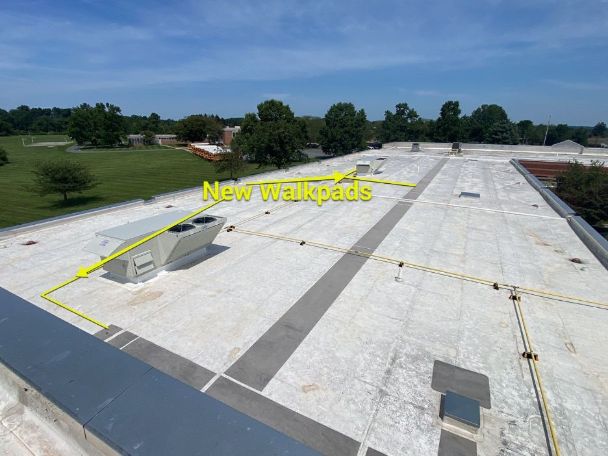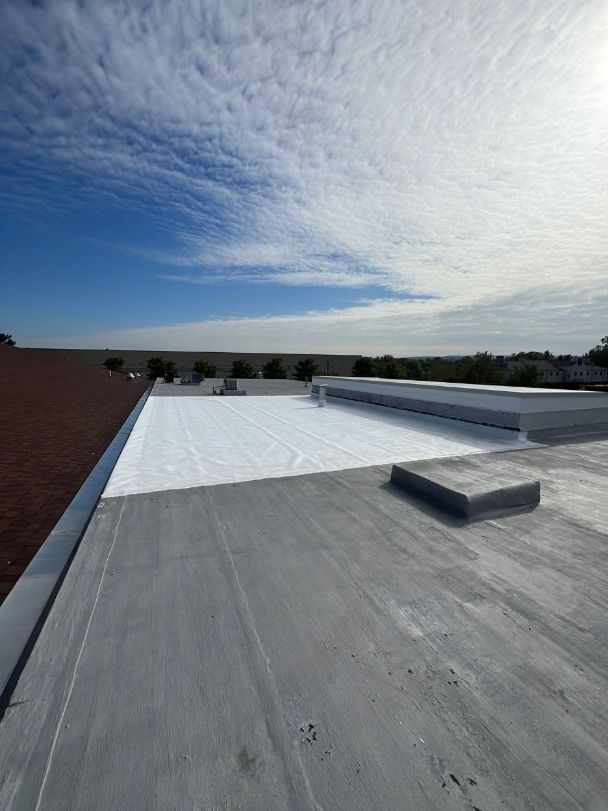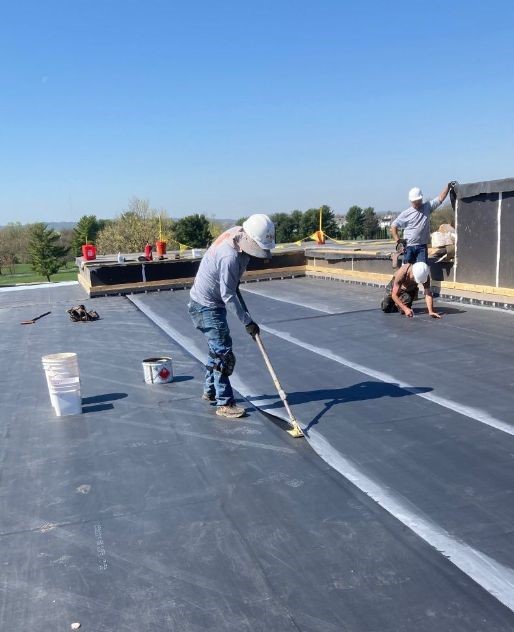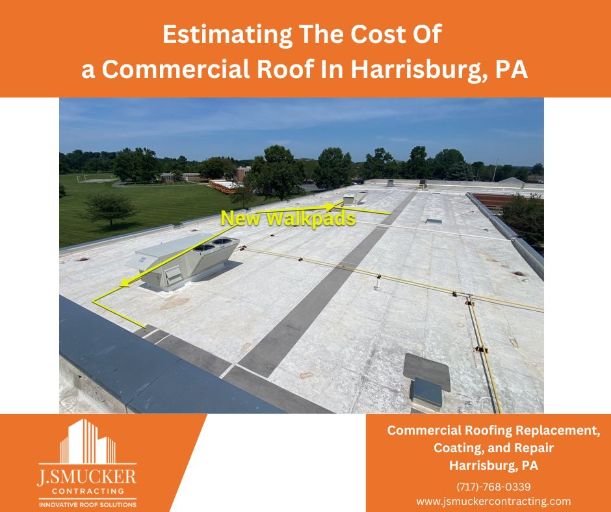- By admin
- Uncategorized
- 0 Comment
Estimating the Cost of a Commercial Roof in Harrisburg, PA
This article aims to equip prospective customers with an understanding of the intricacies involved in estimating the cost of a new commercial roof. We’ll address why one can’t simply visit a contractor’s website or have a brief conversation with a roofer to get a straightforward quote. This article is intended to emphasize the multifaceted nature of commercial roofing projects and really highlight the critical need for an in-person evaluation. By doing so, we hope to make you, the customer, more familiar and comfortable with the steps and factors a reputable, skilled, and professional roofing contractor considers before presenting a comprehensive estimate for the work’s scope and expense. You really don’t want to be left in the dark when such an important expense comes down the line!
By this article’s conclusion, you’ll possess a deeper understanding of the many elements involved in estimating roof costs, enabling you to assess a roofing company’s capability to provide a reliable project quote for your upcoming commercial roof replacement or project.
New Roof Variables
Imagine this scenario: You know you need a new roof at some point in the near future, but you’re uncertain about the costs. Perhaps your roof isn’t actively leaking or only has minor leaks…but it’s coming due, and now you’re aiming to set an accurate budget. Often, a quick online search introduces you to contractors who provide vast price estimates, anywhere from $3 to $14 per square foot. This can be misleading for you, the building owner or consumer, due to the many factors at play. More importantly, there are unique considerations tailored to your particular roof. Without a skilled roof inspector assessing your property and determining what’s optimal for your roof and its long-term value, such rapid cost estimates found online lack precision and relevance.
To begin with, commercial roofing systems are generally more intricate than their residential counterparts. They often consist of numerous layers and a diverse range of materials. Thus, determining the cost of replacing such a roof without a direct site assessment is challenging. Furthermore, hidden problems like decay or moisture damage, which might be undetectable at first glance, can influence the project’s expense. All of these factors and more are why it’s crucial to get an expert evaluation before starting any physical work.
The multifaceted nature of roof replacements makes it hard to quote prices based purely on square footage. Reaching out to a roofing expert over a brief call and anticipating any exact square foot estimates is unrealistic without a thorough onsite review.

An on-site roof inspection is absolutely necessary when determining -with accuracy - what a new roofing project will cost
The Intricacies of Commercial Roof Installations
The intricacy of the installation process is a significant consideration that can only truly be gauged once the evaluation team is on the premises. Often, roofing professionals might inform prospective clients through calls or emails that the task will be direct; they plan to remove the existing roof and swiftly replace it. Such a brief overview is, at best, misleading, and at its worst, a considerable warning sign, as providing a precise quote remotely is virtually unfeasible.
The job’s complexity has numerous determining factors. These include the choice of materials, which has implications on labor expenses. How much time and care will be required to designate safe zones during the project? What ground safety measures need to be taken? Are there any traffic issues to address? In the context of large, expansive projects, is there a necessity for crane deployment?
It’s imperative to highlight that given the intricacies and varying aspects of roofing assignments, an accurate cost understanding is only feasible post an on-site roofing assessment. While many roofers might willingly provide rough estimates during phone conversations, those who do so without emphasizing an in-person inspection should be approached with caution.
Roof Size
In the realm of commercial roof replacements, the building’s dimensions play a prominent role. Naturally, a bigger building means more materials and a larger workforce to finish the task. Therefore, the expense associated with installing a new roof is proportionate to the building’s size. While several factors influence the final cost, the building’s area (in square footage) remains a primary factor.
The required materials scale up with an increase in the roof’s design complexity, such as multi-level or steeply pitched roofs. However, it’s worth noting that as the coverage area increases, the expense per square foot often decreases due to economies of scale. For instance, the pricing for a 3,000 square foot roof differs significantly from that of a roof that spans 100,000 square feet.
Labor costs are also tied to the building’s dimensions. A more expansive building mandates more hours and a larger workforce to finalize the project. This timeframe encompasses the removal of the pre-existing roof, surface preparation, and the installation of the new roofing system.
Lastly, the cost for supplementary materials and machinery increases with the building’s size. This takes into account expenses like scaffolding, ladders, and other essential tools to approach the roofing area securely.

Economies of scale will decrease the square footage costs of a larger commercial building project
Roofing Materials
Typically, the materials selected for roofing constitute about 50-60% of the overall budget, with labor expenses accounting for most of the remaining cost. While it’s possible to provide average costs per square foot for each material, such figures wouldn’t truly reflect the financial nuances of a specific roofing project since every building and budget demands a unique evaluation. As highlighted throughout this piece, an in-person roof inspection should take place before any final decisions regarding material choices are made.
Factors such as the building’s design, available budget, local weather conditions, and the building’s intended purpose all influence the optimal roofing choice and the materials best suited for the task. Your roofing expert should guide you, explaining the various available roofing materials and their specific applications. For a great analysis of roofing materials, we suggest checking out our earlier piece titled, “What is the Best Commercial Roofing Material?”
Labor
Labor stands as a primary hurdle influencing the price of a commercial roof replacement. Gaining insight into how labor costs fluctuate allows companies to make educated choices concerning their roof replacements. The nature of work and labor intensity is determined by the roofing materials selected and the intricacy of the roofing task. Like other aspects, labor isn’t a fixed component; it varies based on numerous factors.
For instance, renovating a flat roof generally demands less manpower compared to a more complicated commercial roof with multiple pitches and valleys. Flat roofs tend to be completed faster, while more complex designs can take much longer. The choice of materials also impacts labor requirements; for instance, building a PVC roof demands more hands-on work than that of an EPDM one. The hourly wage of the workforce is another key determinant, contingent upon the type of work, the expertise of the personnel, and the project’s locale, with some regions demanding higher rates (aka New York City vs Fredericksburg, MD).
To reiterate, labor dominates the roofing installation costs. Typically, labor-related expenses for a new roof hover around 30-40% of the total project expenditure, with the majority allocated to materials. Despite being the largest cost component, labor is the trickiest to pinpoint. Multiple factors, from roof intricacy and material choice to traveling time for workers and even seasonal variations (with summer labor usually being better than winter work), make labor estimations complex.

Labor is the largest factor, greater than materials, in the cost of a commercial roofing project.
Do Commercial Warranties Play a Role in Price?
In general terms, warranties don’t really influence the cost of a commercial roof replacement. Warranties provided by manufacturers tend to be consistent within the roofing sector. The only scenario where a warranty might come with a higher price tag is if a customer opts for what is referred to as a ‘total coverage warranty’ — though the name can vary among companies. Total coverage warranties are essentially premium options that come with a labor guarantee equivalent to the materials warranty. Notably, this warranty is offered by the material manufacturer, not the roofing contractor. It’s worth noting that total coverage warranties don’t come cheap, leading many customers to bypass this added protection.
Standard warranties accompanying a commercial roofing project typically encompass the materials warranty from the producer and the labor warranty from the contractor. Thus, from a cost perspective, it’s crucial to recognize that warranties don’t drastically shift the project’s price.
For a deeper dive into warranties, we encourage you to read our detailed article entitled “A Guide to Commercial Roofing Warranties,” prior to pulling the trigger on a new commercial roofing replacement or coating project.
Do Local Building Codes and Permits Play a Part?
Local regulations and permissions can influence the cost of a roofing project, though not as significantly as one might assume. Any roofing undertaking should adhere to local construction regulations (and any reputable contractor understands this). Generally, these local rules are consistent nationwide since they often align with a shared national codebook.
However, variations can arise based on how a local city or county interprets these codes. Moreover, depending on the specific area, there might be a need for distinct permits. Major urban centers like San Francisco or New York City might enforce stricter regulations and require special permits that can, in turn, impact the budget of a roofing endeavor. Regardless, your regional roofing specialist should be well-informed about any specific requirements or permits relevant to your area.
Commercial Roofing Harrisburg, PA - Closing Thoughts
Let’s be real: we’re in a world where we want things now. If we’re after something for our home, we’re quick to jump on Amazon or pop into Best Buy to compare prices. We’ve become experts at online shopping, expecting to figure out how much something will cost quickly.
But, commercial roofs are a whole different ballgame. Every commercial building is like its own puzzle – each piece unique. It’s so well-known in the commercial roofing world that if a contractor tries to give you a price over a call or email without even performing a thorough inspection, you might want to think twice. Why? Because they’re treating your roof like it’s just like every other one out there. And it’s not. Every roofing project is its own unique entity, with challenges galore – each as complex as the last. Everything impacts everything else: the size influences the complexity and the choice of materials; the complexity, in turn, can determine the materials used, and the labor cost is influenced by all of these factors.
Given all this, you’ll want to get your roof inspected before anything else. The good news? Most roofing companies won’t charge you a dime for this. If you’re curious about why these inspections matter so much, check out our earlier piece, “Why Commercial Roof Inspections are So Important.“
If you’re looking for commercial roofing services in and around Harrisburg, PA, reach out to J Smucker Contracting. We pride ourselves on treating each client as one-of-a-kind. We’re here to answer all your queries and give you the best roofing journey ever!

